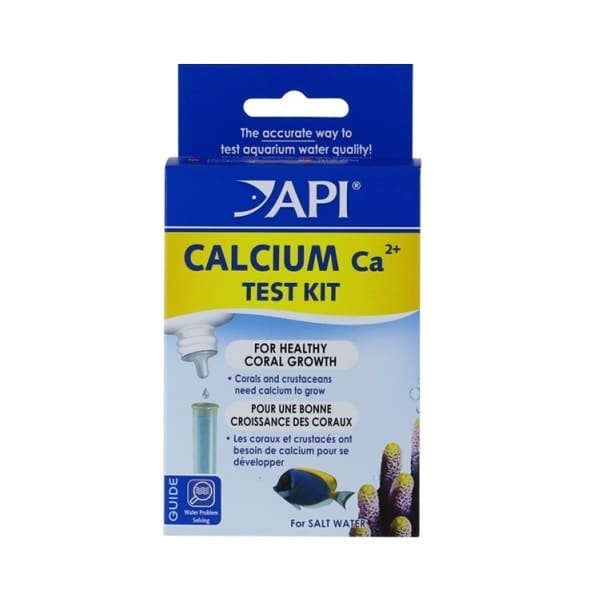Address
Γεωργίου Παπανδρέου 17Α Θεσσαλονίκη 54645
Opening hours
Monday - Friday: 9am - 7pm
Saturday: 9am - 2:30pm
Address
Γεωργίου Παπανδρέου 17Α Θεσσαλονίκη 54645
Opening hours
Monday - Friday: 9am - 7pm
Saturday: 9am - 2:30pm

22.00€
Εξαντλημένο
This kit allows easy and accurate measurement of calcium levels to maintain a healthy aquarium.
Why try if you have calcium levels?
Monitoring calcium levels is essential for maintaining a successful reef aquarium. Reef organisms use calcium to create a calcium carbonate skeleton. Over time, as the calcium in the water is used, the calcium level will gradually decrease. There must be calcium for coral growth Even reef invertebrates such as crustaceans, molluscs and algae require calcium to grow and stay healthy.
Calcium levels decrease as it is used by invertebrates or as it reacts with excess phosphate. Partial water changes can help maintain proper calcium levels, depending on the brand of salt mix. Specific calcium additives are also available. Increased phosphate precipitates calcium, making it unavailable to reef organisms. Phosphate enters the aquarium from tap water and as a by-product of fish and invertebrate metabolism. Use the Aquarium Pharmaceuticals Phosphate Test Kit to test for phosphate. If necessary, use Aquarium Pharmaceuticals Phos-Zorb™ to remove excess phosphate. Phos-Zorb is a special filtering agent that removes phosphate that comes in a flow bag. It fits conveniently into any filter.
Carbonate hardness (KH), often referred to as alkalinity, is important for reef organisms. As carbonate levels decrease the pH becomes unstable The carbonate hardness (KH) level should be 7-10 dKH [125 - 179 mg/L (ppm)] to encourage growth in a reef aquarium and maintain pH. Use the Aquarium Pharmaceuticals KH test kit to measure carbonate hardness. Add the correct pH of 8.2 to increase carbonate hardness and stabilize the pH at 8.2.
Specifications
Test tips:
The Calcium Test Kit reads the calcium concentration in milligrams per liter (mg/L) which is equivalent to parts per million (ppm).
Directions:
Read carefully before testing. Do not allow test solutions to enter the aquarium.
To remove the child safety cover: With one hand, press the red tab on the left with your thumb while unscrewing the lid with your free hand.
Rinse a clean test tube with the water being tested.
Fill the test tube in the line with the water being tested.
Holding the flask vertically, add 10 drops of # 1 calcium test solution to the test tube, cover and shake for 10 seconds.
Vigorously shake the # 2 Calcium Test Solution flask for 10 seconds.
Holding the flask vertically, add Calcium Test Solution # 2, drip into the test tube until the solution changes from pink to blue endpoint. Each drop is equivalent to 20 mg/L (ppm) of calcium (Ca2+). Cover and shake the test tube between drops. Be sure to count the drops added.
A pink colour should form after the first drop.
If a blue color is formed after the first drop, the calcium concentration is 20 mg/L (ppm) or lower.
As the end point is approached, the colour usually changes from pink to purple before finally changing to blue. Once the purple colour has formed, only one or two more drops should be required to reach the blue endpoint.
Note: Reef aquariums should have a calcium (Ca2+) concentration between 400 and 500 mg/L (ppm). To save time, instead of adding only one drop at a time, several drops of # 2 calcium test solution can be added simultaneously at the beginning, then the final drops can be added drop by drop as the end point is approached.
For example, if you believe that the salt water being tested contains approximately 400 mg/L (ppm) of calcium, you can simultaneously add 10 to 15 drops of # 2 calcium test solution as indicated in step 5, then cover and shake. If the solution is pink, continue to add drops, one at a time, until the endpoint is reached. If the solution is blue, then too many drops have been added and the test must be repeated, adding fewer drops initially or adding drops one at a time.
Corrosive:
Bottle # 1:
Keep out of the reach of children.
Eye contact: rinse gently with water for at least 15 minutes.
Remove the contact lens, if present, after the first 5 minutes and continue to rinse.
Skin contact: wash thoroughly with soap and water.
If ingested, contact a doctor or Poison Control Centre immediately.
Bottle # 2:
Contains sodium hydroxide.
Causes severe burns.
Harmful if swallowed.
Keep locked and out of reach of children.
In case of contact with eyes, rinse immediately with plenty of water and seek medical advice. If a contact lens is present, remove after 5 minutes and continue to rinse.
Wear suitable gloves and eye/face protection.
If ingested, contact a doctor or call a Poison Control Center immediately.
In case of an accident or if you feel unwell, seek medical advice immediately (show the label where possible).
| Weight | 0.3 kg |
|---|---|
| Manufacturer | API |
Only logged in customers who have purchased this product may leave a review.
Reviews
There are no reviews yet